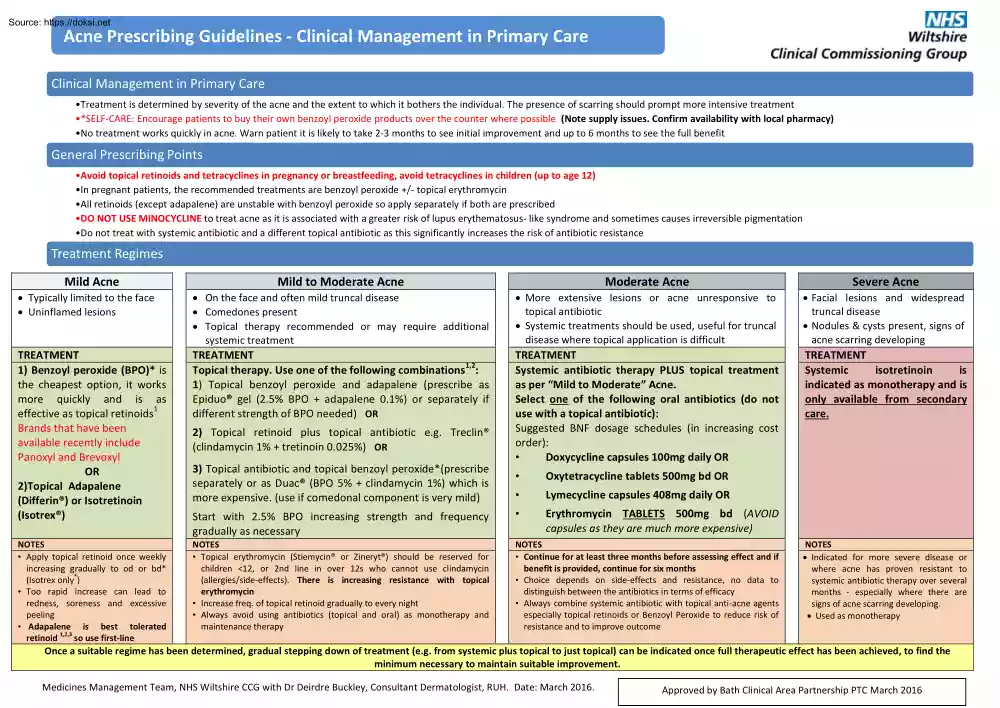Please log in to read this in our online viewer!

Please log in to read this in our online viewer!
No comments yet. You can be the first!
What did others read after this?
Content extract
Acne Prescribing Guidelines - Clinical Management in Primary Care Clinical Management in Primary Care •Treatment is determined by severity of the acne and the extent to which it bothers the individual. The presence of scarring should prompt more intensive treatment •*SELF-CARE: Encourage patients to buy their own benzoyl peroxide products over the counter where possible (Note supply issues. Confirm availability with local pharmacy) •No treatment works quickly in acne. Warn patient it is likely to take 2-3 months to see initial improvement and up to 6 months to see the full benefit General Prescribing Points •Avoid topical retinoids and tetracyclines in pregnancy or breastfeeding, avoid tetracyclines in children (up to age 12) •In pregnant patients, the recommended treatments are benzoyl peroxide +/- topical erythromycin •All retinoids (except adapalene) are unstable with benzoyl peroxide so apply separately if both are prescribed •DO NOT USE MINOCYCLINE to treat acne as
it is associated with a greater risk of lupus erythematosus- like syndrome and sometimes causes irreversible pigmentation •Do not treat with systemic antibiotic and a different topical antibiotic as this significantly increases the risk of antibiotic resistance Treatment Regimes Mild Acne Mild to Moderate Acne Moderate Acne Severe Acne Typically limited to the face Uninflamed lesions On the face and often mild truncal disease Comedones present Topical therapy recommended or may require additional systemic treatment More extensive lesions or acne unresponsive to topical antibiotic Systemic treatments should be used, useful for truncal disease where topical application is difficult Facial lesions and widespread truncal disease Nodules & cysts present, signs of acne scarring developing TREATMENT 1) Benzoyl peroxide (BPO)* is the cheapest option, it works more quickly and is as 1 effective as topical retinoids Brands that have been
available recently include Panoxyl and Brevoxyl OR 2)Topical Adapalene (Differin®) or Isotretinoin (Isotrex®) TREATMENT 1,2 Topical therapy. Use one of the following combinations : 1) Topical benzoyl peroxide and adapalene (prescribe as Epiduo® gel (2.5% BPO + adapalene 01%) or separately if different strength of BPO needed) OR TREATMENT Systemic antibiotic therapy PLUS topical treatment as per “Mild to Moderate” Acne. Select one of the following oral antibiotics (do not use with a topical antibiotic): Suggested BNF dosage schedules (in increasing cost order): • Doxycycline capsules 100mg daily OR TREATMENT Systemic isotretinoin is indicated as monotherapy and is only available from secondary care. NOTES • Apply topical retinoid once weekly increasing gradually to od or bd* (Isotrex only*) • Too rapid increase can lead to redness, soreness and excessive peeling • Adapalene is best tolerated retinoid 1,2,3 so use first-line 2) Topical retinoid plus topical antibiotic
e.g Treclin® (clindamycin 1% + tretinoin 0.025%) OR 3) Topical antibiotic and topical benzoyl peroxide*(prescribe separately or as Duac® (BPO 5% + clindamycin 1%) which is more expensive. (use if comedonal component is very mild) • Oxytetracycline tablets 500mg bd OR • Lymecycline capsules 408mg daily OR Start with 2.5% BPO increasing strength and frequency gradually as necessary • Erythromycin TABLETS 500mg bd (AVOID capsules as they are much more expensive) NOTES • Topical erythromycin (Stiemycin® or Zineryt®) should be reserved for children <12, or 2nd line in over 12s who cannot use clindamycin (allergies/side-effects). There is increasing resistance with topical erythromycin • Increase freq. of topical retinoid gradually to every night • Always avoid using antibiotics (topical and oral) as monotherapy and maintenance therapy NOTES • Continue for at least three months before assessing effect and if benefit is provided, continue for six months •
Choice depends on side-effects and resistance, no data to distinguish between the antibiotics in terms of efficacy • Always combine systemic antibiotic with topical anti-acne agents especially topical retinoids or Benzoyl Peroxide to reduce risk of resistance and to improve outcome NOTES Indicated for more severe disease or where acne has proven resistant to systemic antibiotic therapy over several months - especially where there are signs of acne scarring developing. Used as monotherapy Once a suitable regime has been determined, gradual stepping down of treatment (e.g from systemic plus topical to just topical) can be indicated once full therapeutic effect has been achieved, to find the minimum necessary to maintain suitable improvement. Medicines Management Team, NHS Wiltshire CCG with Dr Deirdre Buckley, Consultant Dermatologist, RUH. Date: March 2016 Approved by Bath Clinical Area Partnership PTC March 2016 Acne Prescribing Guidelines - Clinical Management in
Primary Care Oral Contraceptives •For female patients, combined oral contraceptives may be used in combination with topical treatments or systemic antibiotics •A Cochrane review3 confirmed the efficacy of combined oral contraceptives in treating inflammatory and non-inflammatory acne but found few differences in efficacy between the different types, including cyproterone acetate, which is often recommended •It is therefore not clear whether formulations containing cyproterone acetate (Dianette® which is licensed for severe acne) should be favoured, especially because this agent may increase the risk of venous thromboembolism4. The risk of blood clots in the veins with these medicines is 15 to 2 times higher than for combined oral contraceptives (COCs) containing levonorgestrel and may be similar to the risk with contraceptives containing gestodene, desogestrel or drospirenone. See MHRA Drug Safety Update5 for further information (references below) •If Dianette® is being
used, the need to continue treatment should be evaluated periodically by the treating physician •Progestogen only contraceptives worsen acne •If no contraception is required, discuss pros and cons of hormonal treatment •Recommendations6 are that no additional contraceptive precautions are required when combined oral contraceptives are used with antibacterials that do not induce liver enzymes (e.g Doxycycline), unless diarrhoea or vomiting occur. Please check individual Summary of Product Characteristics for the patient's contraceptive and the chosen antibiotic for specific advice These recommendations should be discussed with the patient. Reasons for Specialist Care •Severe nodulo-cystic acne •Severe social or psychological problems secondary to acne •Scarring •Moderate acne that has failed to respond to treatment i.e lack of any benefit from two courses of different oral antibiotics each lasting at least three months at suggested acne dosage as above or only
partial benefit after 6 months •Suspected underlying endocrinological cause for acne, e.g polycystic ovary syndrome - Refer if necessary to endocrinologist •Diagnostic difficulty (uncommon) •Severe variant of acne such as acne fulminans - very rare severe inflammatory acne with fever, malaise and joint symptoms (very urgent referral) Referral Form - Please include list of all treatments used in referral letter and any concomitant other medication and information regarding other medical conditions Useful Links •British Association of Dermatologists Leaflet on Acne: http://www.badorguk/site/793/defaultaspx •These guidelines are based upon: NICE guidance for GP referral practice; E guidelines for Dermatology; Skin Care Campaign Directory; other secondary care referral guideline sources (Poole General Hospital, London Dermatology Planning Group, Exeter Dermatology Department, Medway Maritime Hospital Department of Dermatology). References 1. BAD guidelines for the management
of acne vulgaris 2013 (draft form- to be published) http://wwwbadorguk/site/1/defaultaspx 2. European guidelines for the management of acne 2011 (expires Oct 2014) http://wwwgooglecouk/url?url=http://wwweurodermorg/edf/indexphp/edf-guidelines/category/4-guidelines-acne%3Fdownload%3D7:guidelinetreatment-of-acne&rct=j&frm=1&q=&esrc=s&sa=U&ved=0ahUKEwjvm-uWvaTKAhWEkw8KHao3AF0QFggUMAA&usg=AFQjCNF5TY8zDnR1gcLw6Px6Stl1msMIjw 3. Arowojolu AO, Gallo MF, Lopez LM, Grimes DA Combined oral contraceptives pills for treatment of acne Cochrane Database System Rev 2012;7:CD004425 http://onlinelibrary.wileycom/doi/101002/14651858CD004425pub6/abstract;jsessionid=6ABF126A581B69C6A47A537CDA0DC8C9f02t04 4. Dawson AL and Dellavalle RP Acne Vulgaris BMJ 8th May 2013;346:f2634 doi:101136/bmjf2634 http://wwwbmjcom/content/346/bmjf2634 5. Cyproterone acetate with ethinylestradiol (co-cyprindiol): balance of benefits and risks remains positiveupdated prescribing advice June 2013
http://wwwmhragovuk/Safetyinformation/DrugSafetyUpdate/CON287002 6. British National Formulary 70th Ed Sept 2015 Medicines Management Team, NHS Wiltshire CCG with Dr Deirdre Buckley, Consultant Dermatologist, RUH. Date: March 2016 Approved by Bath Clinical Area Partnership PTC March 2016
it is associated with a greater risk of lupus erythematosus- like syndrome and sometimes causes irreversible pigmentation •Do not treat with systemic antibiotic and a different topical antibiotic as this significantly increases the risk of antibiotic resistance Treatment Regimes Mild Acne Mild to Moderate Acne Moderate Acne Severe Acne Typically limited to the face Uninflamed lesions On the face and often mild truncal disease Comedones present Topical therapy recommended or may require additional systemic treatment More extensive lesions or acne unresponsive to topical antibiotic Systemic treatments should be used, useful for truncal disease where topical application is difficult Facial lesions and widespread truncal disease Nodules & cysts present, signs of acne scarring developing TREATMENT 1) Benzoyl peroxide (BPO)* is the cheapest option, it works more quickly and is as 1 effective as topical retinoids Brands that have been
available recently include Panoxyl and Brevoxyl OR 2)Topical Adapalene (Differin®) or Isotretinoin (Isotrex®) TREATMENT 1,2 Topical therapy. Use one of the following combinations : 1) Topical benzoyl peroxide and adapalene (prescribe as Epiduo® gel (2.5% BPO + adapalene 01%) or separately if different strength of BPO needed) OR TREATMENT Systemic antibiotic therapy PLUS topical treatment as per “Mild to Moderate” Acne. Select one of the following oral antibiotics (do not use with a topical antibiotic): Suggested BNF dosage schedules (in increasing cost order): • Doxycycline capsules 100mg daily OR TREATMENT Systemic isotretinoin is indicated as monotherapy and is only available from secondary care. NOTES • Apply topical retinoid once weekly increasing gradually to od or bd* (Isotrex only*) • Too rapid increase can lead to redness, soreness and excessive peeling • Adapalene is best tolerated retinoid 1,2,3 so use first-line 2) Topical retinoid plus topical antibiotic
e.g Treclin® (clindamycin 1% + tretinoin 0.025%) OR 3) Topical antibiotic and topical benzoyl peroxide*(prescribe separately or as Duac® (BPO 5% + clindamycin 1%) which is more expensive. (use if comedonal component is very mild) • Oxytetracycline tablets 500mg bd OR • Lymecycline capsules 408mg daily OR Start with 2.5% BPO increasing strength and frequency gradually as necessary • Erythromycin TABLETS 500mg bd (AVOID capsules as they are much more expensive) NOTES • Topical erythromycin (Stiemycin® or Zineryt®) should be reserved for children <12, or 2nd line in over 12s who cannot use clindamycin (allergies/side-effects). There is increasing resistance with topical erythromycin • Increase freq. of topical retinoid gradually to every night • Always avoid using antibiotics (topical and oral) as monotherapy and maintenance therapy NOTES • Continue for at least three months before assessing effect and if benefit is provided, continue for six months •
Choice depends on side-effects and resistance, no data to distinguish between the antibiotics in terms of efficacy • Always combine systemic antibiotic with topical anti-acne agents especially topical retinoids or Benzoyl Peroxide to reduce risk of resistance and to improve outcome NOTES Indicated for more severe disease or where acne has proven resistant to systemic antibiotic therapy over several months - especially where there are signs of acne scarring developing. Used as monotherapy Once a suitable regime has been determined, gradual stepping down of treatment (e.g from systemic plus topical to just topical) can be indicated once full therapeutic effect has been achieved, to find the minimum necessary to maintain suitable improvement. Medicines Management Team, NHS Wiltshire CCG with Dr Deirdre Buckley, Consultant Dermatologist, RUH. Date: March 2016 Approved by Bath Clinical Area Partnership PTC March 2016 Acne Prescribing Guidelines - Clinical Management in
Primary Care Oral Contraceptives •For female patients, combined oral contraceptives may be used in combination with topical treatments or systemic antibiotics •A Cochrane review3 confirmed the efficacy of combined oral contraceptives in treating inflammatory and non-inflammatory acne but found few differences in efficacy between the different types, including cyproterone acetate, which is often recommended •It is therefore not clear whether formulations containing cyproterone acetate (Dianette® which is licensed for severe acne) should be favoured, especially because this agent may increase the risk of venous thromboembolism4. The risk of blood clots in the veins with these medicines is 15 to 2 times higher than for combined oral contraceptives (COCs) containing levonorgestrel and may be similar to the risk with contraceptives containing gestodene, desogestrel or drospirenone. See MHRA Drug Safety Update5 for further information (references below) •If Dianette® is being
used, the need to continue treatment should be evaluated periodically by the treating physician •Progestogen only contraceptives worsen acne •If no contraception is required, discuss pros and cons of hormonal treatment •Recommendations6 are that no additional contraceptive precautions are required when combined oral contraceptives are used with antibacterials that do not induce liver enzymes (e.g Doxycycline), unless diarrhoea or vomiting occur. Please check individual Summary of Product Characteristics for the patient's contraceptive and the chosen antibiotic for specific advice These recommendations should be discussed with the patient. Reasons for Specialist Care •Severe nodulo-cystic acne •Severe social or psychological problems secondary to acne •Scarring •Moderate acne that has failed to respond to treatment i.e lack of any benefit from two courses of different oral antibiotics each lasting at least three months at suggested acne dosage as above or only
partial benefit after 6 months •Suspected underlying endocrinological cause for acne, e.g polycystic ovary syndrome - Refer if necessary to endocrinologist •Diagnostic difficulty (uncommon) •Severe variant of acne such as acne fulminans - very rare severe inflammatory acne with fever, malaise and joint symptoms (very urgent referral) Referral Form - Please include list of all treatments used in referral letter and any concomitant other medication and information regarding other medical conditions Useful Links •British Association of Dermatologists Leaflet on Acne: http://www.badorguk/site/793/defaultaspx •These guidelines are based upon: NICE guidance for GP referral practice; E guidelines for Dermatology; Skin Care Campaign Directory; other secondary care referral guideline sources (Poole General Hospital, London Dermatology Planning Group, Exeter Dermatology Department, Medway Maritime Hospital Department of Dermatology). References 1. BAD guidelines for the management
of acne vulgaris 2013 (draft form- to be published) http://wwwbadorguk/site/1/defaultaspx 2. European guidelines for the management of acne 2011 (expires Oct 2014) http://wwwgooglecouk/url?url=http://wwweurodermorg/edf/indexphp/edf-guidelines/category/4-guidelines-acne%3Fdownload%3D7:guidelinetreatment-of-acne&rct=j&frm=1&q=&esrc=s&sa=U&ved=0ahUKEwjvm-uWvaTKAhWEkw8KHao3AF0QFggUMAA&usg=AFQjCNF5TY8zDnR1gcLw6Px6Stl1msMIjw 3. Arowojolu AO, Gallo MF, Lopez LM, Grimes DA Combined oral contraceptives pills for treatment of acne Cochrane Database System Rev 2012;7:CD004425 http://onlinelibrary.wileycom/doi/101002/14651858CD004425pub6/abstract;jsessionid=6ABF126A581B69C6A47A537CDA0DC8C9f02t04 4. Dawson AL and Dellavalle RP Acne Vulgaris BMJ 8th May 2013;346:f2634 doi:101136/bmjf2634 http://wwwbmjcom/content/346/bmjf2634 5. Cyproterone acetate with ethinylestradiol (co-cyprindiol): balance of benefits and risks remains positiveupdated prescribing advice June 2013
http://wwwmhragovuk/Safetyinformation/DrugSafetyUpdate/CON287002 6. British National Formulary 70th Ed Sept 2015 Medicines Management Team, NHS Wiltshire CCG with Dr Deirdre Buckley, Consultant Dermatologist, RUH. Date: March 2016 Approved by Bath Clinical Area Partnership PTC March 2016




